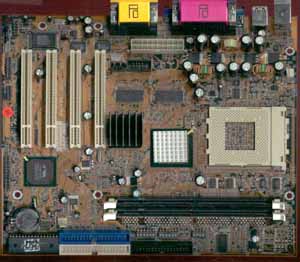Chaintech CT-7AIV2 Socket-A KT133 microATX
by Henry Kuo on October 5, 2000 3:07 AM EST- Posted in
- Motherboards
Chaintech is a motherboard manufacturer not known by many. This, however, does not mean their motherboard solutions are not up to par with some of the bigger companies like ABIT, ASUS, and Microstar. They are growing and constantly delivering quality motherboards such as the CT-6BTM and the CT-6AIA. The company’s main focus has been on quality and stability, items that are demonstrated in most of their products.
We have yet to see a reason for motherboard manufacturers to stay away from making motherboards for use with AMD processors. Even Iwill, a company that has historically stayed with Intel, released the KV200 and the KV200-R for AMD Socket-A CPUs. Since the AMD processor market is growing so rapidly, motherboard manufacturers are fiercely competing against each other for this piece of the market.
There are a lot of ways for manufacturers to attract buyers. Some make motherboards with the best performance. Some put in more advanced options for high-end users. Some make well-rounded motherboards for OEMs. It is definitely a good idea to include all of the above on one board, but that is virtually impossible, either economically or technically.
Chaintech has a couple of motherboards equipped with the VIA KT133 chipset, and one of those is the CT-7AIV2. If we were to categorize this motherboard, it will fall into the OEM market. How does this micro-ATX motherboard compare to other KT133 motherboards? Let’s find out.
|
Chaintech CT-7AIV2 |
|
|
CPU
Interface
|
Socket-A
|
|
Chipset
|
VIA
KT133
|
|
Form
Factor
|
micro-ATX
|
|
Bus
Speeds
|
100
/ 102 / 103 / 107 / 110 / 113 / 117 / 120 MHz
|
|
Voltages
Supported
|
Auto Detect
|
|
Memory
Slots
|
2
168-pin DIMM Slots
|
|
Expansion
Slots
|
0
AGP Slots |
|
On-board
Audio
|
C-Media
CMI-8738 3D 4.1 Hardware Sound
|
|
On-board
Video
|
NVidia
TNT2 M64 32MB
|
|
BIOS
|
Award
Modular BIOS 6.00PG
|
The Good
The Chaintech CT-7AIV2 measures 9.5 by 8.5 inches, which is reasonable for a micro-ATX board. The nice thing about micro-ATX boards is that they use smaller PCBs, resulting in lower manufacturing costs. This is important for OEMs since they always want to reduce their costs so that they can price their systems lower.
One big disadvantage of the micro-ATX format, unfortunately, is the overcrowded environment. As you can see, at least for the Chaintech CT-7AIV2, the 462-pin Socket-A sits right at the edge of the motherboard, which means it will be directly under the power supply when seated inside the case. Next to the socket is the VIA 8363 North Bridge (under the silver heat sink), and right next to the North Bridge is the NVidia TNT2 M64 chip (under the black heat sink). These three components generate considerably amount of heat. With the SDRAM sitting right in front of these chips, a large amount of heat is trapped here, a situation that will only get worse when overclocking. In our test lab, after running the system for 24 hours, we could hardly touch the video card heat sink or the bottom of the board with our bare hands.
The power supply connector is next to the serial / parallel ports and a bit left of the socket. This means that you will have to run your ATX power cable over the memory and the CPU, potentially cluttering the case with cables. So far from what we have seen, the best place to place the power supply connector is the right edge of the PCB, where it will be directly under the power supply inside the case, so the cables do not have to run over the CPU and memory. However, putting the connector on the right edge can be really hard in the case of micro-ATX where space is a big concern.
The VIA 8363 North Bridge is the core of the KT133 chipset, providing the major features of the KT133, including the 133 MHz memory bus and AGP 4X support. In the case of the CT-7AIV2, the on-board TNT2 M64 takes advantage of that AGP 4X interface, so there is no AGP slot.











0 Comments
View All Comments